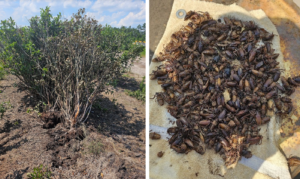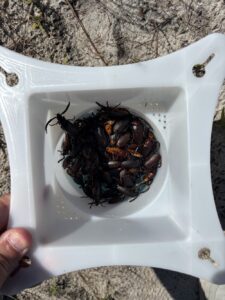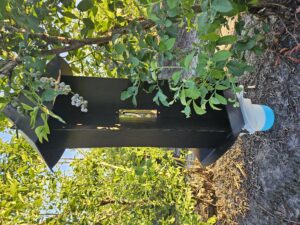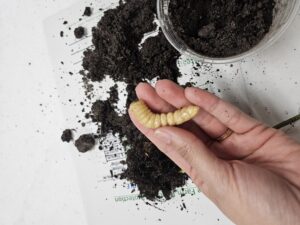The Root of the Problem: Prionus Longhorn Beetles in Blueberries
go.ncsu.edu/readext?1016443
en Español / em Português
El inglés es el idioma de control de esta página. En la medida en que haya algún conflicto entre la traducción al inglés y la traducción, el inglés prevalece.
Al hacer clic en el enlace de traducción se activa un servicio de traducción gratuito para convertir la página al español. Al igual que con cualquier traducción por Internet, la conversión no es sensible al contexto y puede que no traduzca el texto en su significado original. NC State Extension no garantiza la exactitud del texto traducido. Por favor, tenga en cuenta que algunas aplicaciones y/o servicios pueden no funcionar como se espera cuando se traducen.
Português
Inglês é o idioma de controle desta página. Na medida que haja algum conflito entre o texto original em Inglês e a tradução, o Inglês prevalece.
Ao clicar no link de tradução, um serviço gratuito de tradução será ativado para converter a página para o Português. Como em qualquer tradução pela internet, a conversão não é sensivel ao contexto e pode não ocorrer a tradução para o significado orginal. O serviço de Extensão da Carolina do Norte (NC State Extension) não garante a exatidão do texto traduzido. Por favor, observe que algumas funções ou serviços podem não funcionar como esperado após a tradução.
English
English is the controlling language of this page. To the extent there is any conflict between the English text and the translation, English controls.
Clicking on the translation link activates a free translation service to convert the page to Spanish. As with any Internet translation, the conversion is not context-sensitive and may not translate the text to its original meaning. NC State Extension does not guarantee the accuracy of the translated text. Please note that some applications and/or services may not function as expected when translated.
Collapse ▲Prionus longhorn beetles, notably Prionus laticollis, Prionus imbricornis, and Prionus californicus (Coleoptera: Cerambycidae), pose significant challenges in agricultural and forestry management in the U.S. due to their damaging larval stages. These species are woodborers that can devastate tree roots, impacting crop yields and forest health. In the last decade, Prionus beetles have emerged as a problem in the blueberry-producing region of North Carolina. Thus, this publication aims to increase awareness of the problem and provide a basic description of Prionus beetles.
CALL TO THE SMALL FRUIT COMMUNITY:
Developing effective management of Prionus species in blueberries requires a comprehensive understanding of their biology, regular monitoring, and integrated tactics. Thus, community-wide coordination is crucial for effectively diagnosing infestations and collecting information about these pests. If you have seen these beetles on or near your blueberries, please contact the small fruit entomologist, Lorena Lopez, at llopezq@ncsu.edu.
Identification and Biology
Prionus laticollis (Broad-necked Root Borer): These beetles can grow up to 2 inches in length (adults). They have a blackish to reddish-brown coloration and are commonly found in the eastern U.S., where they primarily affect fruit trees like apple and cherry.
Prionus imbricornis (Tilehorned Prionus): Similar in size to P. laticollis, they are distinguished by their antenna, which is segmented and appears saw-like. This species is found across the eastern and central U.S. Adult beetles of eastern species of Prionus (P. laticollis and P. imbricornis) typically become active and are visible from late June through the first week of August, with a peak in mid-July. Warmer temperatures in the southeast can cause faster development and adult emergence as early as April or May.
Prionus californicus (California Root Borer): The largest, growing up to 3 inches (adults), found predominantly in the western U.S., affecting crops such as hops and stone fruits like peaches. Adults generally emerge from late June through August.
All three species have similar lifecycles, beginning as eggs laid in the soil near host trees. The larvae (up to 3.5 inches before pupating) cause the most damage by feeding on the roots for several years (3-5 years) before pupating in the soil and emerging as adults. Adults are typically nocturnal and are active from late spring to late summer, depending on the species and environmental conditions.
Host Plants and Damage
These beetles target a variety of crops and woody plants across different regions. These beetles’ larval stage is primarily responsible for the damage, as they bore into the roots and sometimes the lower trunk portions of the trees, causing structural weaknesses and increased susceptibility to diseases and environmental stresses. The larvae impair the plant’s ability to absorb water and nutrients, leading to reduced vigor and, eventually, death. Adults may or may not feed during their lifespan (1-2 months). Affected plants often exhibit canopy dieback and may be easily uprooted due to weakened root systems. Early detection is crucial to mitigate the impact on these economically important crops and trees.
Fruit Trees:
- Apple trees are commonly targeted, showing signs of gradual thinning and yellowing of foliage and eventual limb-by-limb mortality.
- Cherry trees, along with other stone fruits such as peach and plum, are also affected. These beetles tend to hollow out, girdle, or sever the wood of roots and crowns.
- Pecan trees suffer particularly when old orchards begin to decline, showing weakening limbs over the years.
Ornamental and Forest Trees:
- Cottonwood and native ornamental trees and shrubs are listed as hosts, experiencing damage similar to that seen in fruit trees.
- Oak, hickory, and other hardwood trees are also vulnerable to Prionus beetle infestations, especially in settings where these trees are prevalent.
Other Plants:
- Hops, an essential crop in brewing, and hazelnuts (fruit tree), face challenges from Prionus californicus, particularly in the western U.S.
Prionus Beetles in North Carolina Blueberries
In October 2010 and again in January 2013 growers reported ‘Duke’ highbush blueberry fields with severe damage to roots and crowns caused by grubs feeding on the underground parts of the plants. To our knowledge, this is the only report of Prionus beetles feeding on commercial blueberries. The infestation was reported in a commercial farm in the blueberry-producing area of North Carolina in the south coastal area, where most of the commercial blueberries are grown.
In early summer 2024, a severe infestation with Prionus larvae was again reported in the same area in ‘Duke’, O’Neal’, ‘Star’, and ‘Legacy’ highbush blueberry cultivars. After confirming the presence of advanced instar grubs in multiple plants in one of the locations, pheromone traps were placed in three locations in the state to monitor adult emergence.

Signs of severe Prionus infestation in a commercial blueberry planting in Bladen County, NC. Uprooted blueberry bushes due to debilitated root and crown (left). Hundreds of Prionus adults accumulated in two weeks (June 2024) on one panel trap (right) (Photos by L. Lopez)
Table 1. Prionus beetle monitoring program in highbush blueberries in North Carolina (2024). Black panel traps + Alpha Scents lures and pitfall traps + Alpha Scents were used (pooled data shown). Monitoring started on 6/15/2024 (week 1), and the last set of data was collected on 7/26/2024 (week 7) (L. Lopez, unpublished data). This ongoing monitoring program will continue until mid-August.
| NC County | ||||
| Sampling Week | Bladen | New Hanover | Forsyth | Total |
| 1 | 229 | 6 | Not checked | 235 |
| 2 | Not checked | Not checked | Not checked | Not checked |
| 3 | 83 | 7 | 0 | 90 |
| 4 | 271 | Not checked | 0 | 271 |
| 5 | 100 | 9 | 0 | 109 |
| 6 | 32 | Not checked | 1 | 33 |
| 7 | 20 | 27 | 0 | 20 |
| Total | 735 | 49 | 1 | 785 |
| Location details | Commercial blueberry farm (conventional) | NCSU’s Horticultural Crops Research Station | Pick-your-own small farm (organic) |
Monitoring and Detection
Pheromone Traps: Specific pheromones have been identified for attracting males of each species, crucial for monitoring populations and peak activity periods. Pheromone lures and panel traps (in combination), and pitfall traps are the standard monitoring methods for longhorn beetles. These are commercially available from Alpha Scents and Great Lakes IPM.
Visual Inspection: Regular inspections of the lower trunk and root crown areas for signs of frass and boreholes can help identify infestations early for forest and some fruit tree crops. However, hardly any evidence of infestation can be observed in blueberry bushes infested with Prionus beetles. Only when plants are uprooted, the girdling and galleries can be observed in the roots and crown of the trees. By then, blueberry bushes are weakened, wilting, and can easily be knocked down by hand or mechanical harvesters.

Prionus beetles collecting using a panel trap with an Alpha Scents lure in NC blueberries (Photo by B. Hardison)
Management Strategies
Prionus’ long developmental stage makes them difficult to study and control. There are no clear guidelines on how to manage Prionus beetles, but we are working closely with growers to find suitable solutions for blueberry growers to address this pest. It is important to highlight that these are not the same as other cerambycid pests of blueberry, such as the blueberry stem borer or the flatheaded borer (Coleoptera: Buprestidae), which feed on the blueberry bushes for a few weeks.
Cultural Controls: Most of these Prionus species are attracted to mature and stressed plants. Remove and destroy infested plants to prevent the spread of larvae. Exposing larvae by removing soil around the roots and physically removing them can be effective on a small scale.
Chemical Controls: There are no registered insecticides against Prionus beetles infesting blueberries. Soil applications of appropriate insecticides are only effective against other blueberry borers, such as the stem and flatheaded borers. Additionally, systemic insecticides are not effective against large grubs of Prionus (up to 3.5 inches long), and there is little information about their effectiveness against smaller larvae. Also, these insecticides are not available for use in organic blueberries.
Acknowledgements: We wish to thank Tiffanee Boone, Celine Richard, and Brad Hardison (Pender, Sampson, and Forsyth County Extension agents) for their help servicing the traps at each location, Bill Cline for his contributions to this preliminary study, and the collaborating growers.
References
North Carolina Small Fruit & Specialty Crop IPM. (2013, January). Prionus larvae found on blueberry. Retrieved from https://ncsmallfruitsipm.blogspot.com/2013/01/Prionus-larvae-found-on-blueberry.html
Oregon State University Extension. (2023). Pest alert: California root borer in hazelnuts. Retrieved from https://blogs.oregonstate.edu/hazelnuts/pest-alert-california-root-borer-in-hazelnuts/
University of Georgia Pecan Extension. (2016). Prionus Root Borers. Retrieved from https://site.extension.uga.edu/pecan/2016/06/Prionus-root-borers/
Utah State University Extension. (2010). Prionus Borers (Prionus californicus). Retrieved from https://digitalcommons.usu.edu/cgi/viewcontent.cgi?article=1653&context=extension_curall




